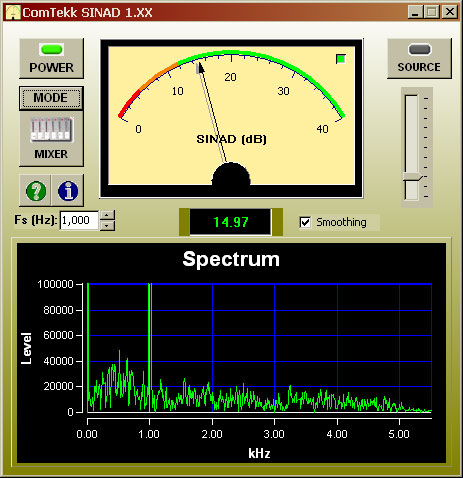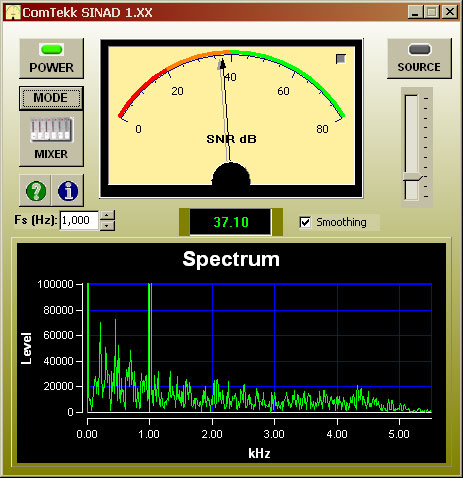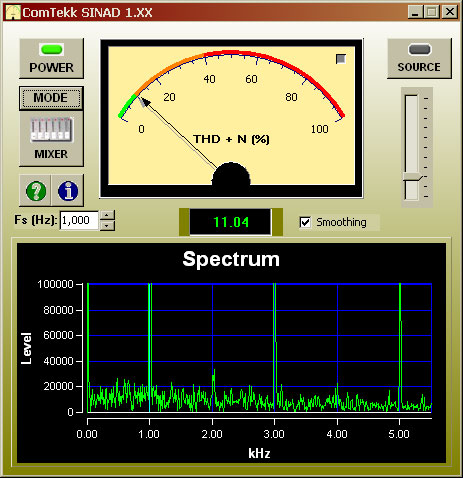Making Direct Measurements
2. Measuring Signal-to-Noise ratio
3. Measuring Total Harmonic Distortion
4. Measuring Total Harmonic Distortion + Noise
1. Measuring SINAD

What is SINAD?
SINAD is the quantitative ratio of (Signal+Noise+Distortion) to (Noise+Distortion) expressed in dB (deciBels). "Signal" denotes the desired 1KHz tone. Everything else is considered to be "Noise & Distortion." SINAD is only useful when another outside factor is known, such as RF signal level. This is useful for measuring receiver sensitivity, among other things. SINAD is sometimes referred to as (S+N)/N. This method may be used for AM or FM analog (not digital) modulation.
See also: http://en.wikipedia.org/wiki/SINAD
Example
Let's measure a receiver's sensitivity at 12dB SINAD. This is probably the most common specification given by manufacturers when assigning a numeric value to receiver sensitivity. Here are the steps:
- Connect equipment as described in Test Equipment Setup.
- Run CTSinad, activating the POWER button. Turn on the SOURCE generator if needed and adjust modulation for about 1KHz deviation indicated on RF signal generator. Be sure the MODE is set to SINAD. Deviation should be approx. 12.5% of the channel spacing (half for narrow-band).
- Set the RF output to 1uV or -107dBm. Increase level if needed to open the receiver's squelch.
- Adjust receiver volume control if needed to give a 50% or better indication of 1KHz signal on the spectrum display. Note the indication on the SINAD meter.
- Now adjust the frequency of Fs up and down a few clicks to find where the meter peaks. This will compensate for any clock-frequency error inherent in your sound card.
- Increase or reduce the RF level until a reading of 12dB SINAD is reached.
- Note the RF generator level - this is your receiver's 12dB SINAD sensitivity!
- If you are aligning the receiver, follow the instructions in the service manual to obtain the best sensitivity.
For more about SINAD measurements, see MRT's article on the subject:
http://mrtmag.com/mag/radio_versatile_sinad_meter/
2. Measuring SNR (Signal to Noise Ratio)

Some radio manufacturers will specify receiver sensitivity in terms of SNR rather than SINAD. This is often the case for HF or microwave (RADAR) receivers.
SNR is simply the ratio of "Signal" to "Noise", expressed in dB (deciBels). "Signal" is the desired 1KHz tone. "Noise" is everything else within the bandpass filter's range of 300Hz to 3KHz.
To measure SNR, follow the steps for measuring SINAD above, but set CTSinad to indicate SNR using the MODE button.
Radio Electronics has an excellent article detailing the use of SNR measurements for two-way radio:
http://www.radio-electronics.com/info/receivers/sensitivity/signal_noise_ratio.php
For more information about SNR see:
http://en.wikipedia.org/wiki/Signal-to-noise_ratio
3. Measuring THD (Total Harmonic Distortion)

THD is a good indicator of receiver quality, found by measuring the 2nd and 3rd harmonics of the desired Signal and comparing the total of both levels to that of the 1KHz source. 4th, 5th harmonics fall outside the 3KHz bandpass filter and are thus not taken into account. THD is a ratio, usually expressed as a percentage of the desired Signal.
To measure THD, follow the steps for measuring SINAD above, but set CTSinad to indicate THD using the MODE button.
When the harmonics are significant, you can actually see them on the spectral display. This can be demonstrated by slowly increasing the RF generator's deviation until the harmonics become visible.
For more information about THD see:
http://en.wikipedia.org/wiki/Total_harmonic_distortion
4. Measuring THD+N (Total Harmonic Distortion plus Noise)

This measurement is a more common spec than THD and gives a more repeatable comparison between devices. Since it encompasses SNR and THD, it is the obvious choice for a single-point performance comparision of different receivers.
To measure THD+N, follow the steps for measuring SINAD above, but set CTSinad to indicate THD+N using the MODE button.
For more information about THD+N see:
http://en.wikipedia.org/wiki/Total_harmonic_distortion
5. Indirect measurements
These measurements include a higher degree of difficulty and typically require additional RF signal generators. This information is provided as reference material only.
Intermodulation Rejection - Ability of a receiver to reject two hi-level signals with 3rd-order intermod products falling within the receiver frequency bandpass. This is the ratio of interfering signal to wanted signal.
Found by measuring the reference sensitivity (12dB SINAD for example), then increasing the RF signal by 3dB and adding 2 more interfering signals of equal amplitude (one is normally modulated at 400Hz). Continue incrementing signal amplitude until SINAD degrades to the original value.
Adjacent Channel Rejection - Ability of a receiver to demodulate desired signal while there is a strong signal present at the adjacent channel.
To measure is a similar process as above for intermod. An interfering signal is added at the next adjacent channel frequency (modulated at 400Hz) and increased until SINAD has degraded back to the original value. Rejection is the ratio of interfering signal to wanted signal.
Receiver Blocking - Ability of a receiver to block (reject) a strong signal far from the receive frequency. Again, the RF (wanted) signal is increased 3dB above the 12dB SINAD point. A CW (unmodulated) carrier is applied at another frequency well away from where the receiver is tuned and increased until SINAD returns to original [12dB] level. The process is repeated at mutilple frequencies to check for linearity.
Disclaimer:
The author and owners of this software offer no warranties or guarantee of accuracy with any particular hardware/software configuration and accepts no liability for its use or damages from use or mis-use.
